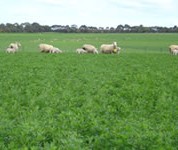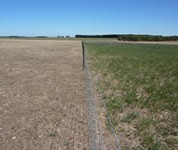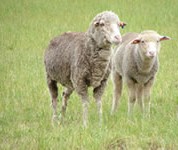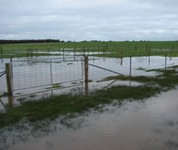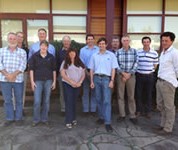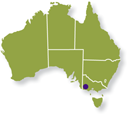Key Results
Click on a key result to see the data
Perennial Persistence and Composition
- All perennials except kikuyu and chicory persisted for more than seven years from putting the right plant in the right place with the right management.
Pasture Production
- Triple (lucerne, perennial ryegrass and summer active tall fescue) and Ryegrass (early, mid and late finishing perennial ryegrass) pasture systems produced 8-12 tonnes DM/ha/year. Lucerne and chicory produced 1-3 tonnes DM/ha over the summer period.
Production and Economics
- Stocking rates were 25-31 DSE/ha from 2006-2010 compared to 16 DSE/ha for the average benchmarked South West Farm Monitor (SWFM) farm over the same period.
- Average lamb weaning percentages were approximately 92% for Merino ewes and 141% for Coopworth ewes compared to 80% and 118% for the average South West Farm Monitor. Profit of Coopworths and Merinos were similar despite the lower weaning percentages from Merinos.
- Twin lamb survival increased by 15% when lambs were given shelter.
- Wool production varied with the sheep system from 35-64 kg clean wool/ha compared with 35-46 kg clean wool/ha for the South West Farm Monitor top 20%.
- Lamb production ranged from 351-774 kg/ha compared with 215-374 kg/ha for the top 20% South West Farm Monitor. Beef steer live-weight production per hectare ranged from 644-928 kg/ha compared to 579-732 kg/ha.
- Including lucerne in the Triple system reduced supplementary feeding cost compared to the Ryegrass system by $20/hd or $300/ha over the 2007 summer following the 2006 drought.
- Average gross margins of $617/ha (Triple system) and $564/ha (Ryegrass system) exceeded the top 20% South West Farm Monitor prime lamb production systems ($484/ha) by 16% and 24% respectively, and the average system ($282/ha) by more than 100%.
- Internal rate of return from establishing EverGraze systems on 10% of the farm is estimated to be 10-27% with payback of 6-7 years.
- Post-experimental modelling confirmed higher profits of $512/ha (Perennial Ryegrass System) and $499/ha (Triple System) compared to $12/ha for a base-case traditional south west region wool production system.
Water use of different perennial species
- Measurements of water use confirmed that on the crests, lucerne fully controlled water loss below the root zone. Chicory also controlled leakage until its density declined three years after sowing. Tall fescue and perennial ryegrass used more water on the valley floors compared to annual pasture.
Publications
Report
EverGraze Impact Report – June 2011 to June 2012
The purpose of this report is to summarise the Impact of the EverGraze project based on evaluation data collected from activities between July 2011 and June 2012. This impact analysis will provide a basis for monito…
Read MoreEverGraze; 2012; EverGraze
Tool
Shelter For Lambing Tool
At the Hamilton and Wagga Wagga Proof Sites, perennial grass hedges and shrub nurseries provided very effective shelter, reducing wind chill by up to 99%. At Hamilton, this reduced the average number of days with po…
Read MoreMcCaskill M, Beattie L; 2013; EverGraze
Select
Summer-active perennials in pasture systems improve seasonal pasture distribution without compromising winter-spring production
Improved dryland pastures for sheep and beef cattle production in south-western Victoria are typically based on summer-dormant cultivars of perennial ryegrass (Lolium perenne L.) or phalaris (Phalaris aquatica L.)….
Read MoreWard G , Clark S, Kearney G, McCaskill M, Raeside M , Lawson A, Behrendt R; 2013; CSIRO Journal of Crop & Pasture Science
Fact sheet
Techniques for Measuring Pastures
Pasture measurements are integral to grassland experimentation. Such measurements are equally essential whether assessing the herbage present in a pasture, examining changes in growth or pasture quality during the g…
Read MoreCayley J, Bird P; First published 1991, revised 1996; DEPI Victoria
Journal article
Can summer-active perennial species improve pasture nutritive value and sward stability?
Although generally well adapted and productive, the summer-dormant perennial pastures of southern Australia do not provide a year-round, high nutritive value feed base, they fail to respond to summer rainfall, and t…
Read MoreClark S, Ward G, Kearney G, Lawson A, McCaskill M, O’Brien B, Raeside M, Behrendt R; 2013; CSIRO Journal of Crop & Pasture Science
Webpage
EverGraze Exchange – Livestock Systems (Online)
This Online EverGraze Exchange provides information on the key factors driving livestock productivity and enterprise profitability. A process is included for evaluating your livestock system to identify opportunitie…
Read MoreKate Sargeant, Geoff Saul, Ralph Behrendt, Michael Friend, Paul Sanford; 2013; EverGraze, Future Farm Industries CRC
Video or Audio
EverGraze Video
Overview on the EverGraze Hamilton site in Victoria with David Robertson, EverGraze SW Advisory Committee Chair.
Read MoreEverGraze Future Farm CRC; 2010; EverGraze
Video or Audio
About EverGraze Video
EverGraze is developing and testing new farming systems in different environments across the high rainfall zone of southern Australia. The target is to increase profits of sheep and cattle enterprises by up to 50% a…
Read MoreAWI; 2012; EverGraze
Report
Hamilton EverGraze Proof Site: Report on the impact of changing management regimes on profitability
The experiment at the Hamilton Proof site at PVI was conducted by EverGraze between 2006 and 2010. The ‘Standard’ livestock enterprise run at the site was a Merino ewe joined to a Terminal ram. The second system run…
Read MoreWarn L; 2011; Mackinnon, University of Melbourne
Report
MIDAS modelling for Hamilton EverGraze site
Pre-experimental modelling was carried out for the EverGraze project using estimates of pasture production and quality for perennial ryegrass, lucerne and summer active tall fescue (Young et al 2004).The initial est…
Read MoreYoung J, Bathgate A, Behrendt R; 2011; EverGraze

